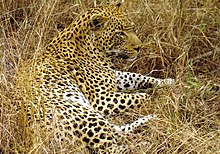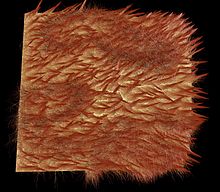Fur

Fur is a thick growth of
The fur of mammals has many uses: protection, sensory purposes, waterproofing, and camouflaging, with the primary usage being thermoregulation.[2] The types of hair include[3]: 99
- definitive, which may be shed after reaching a certain length;
- vibrissae, which are sensory hairs and are most commonly whiskers;
- pelage, which consists of guard hairs, under-fur, and awn hair;
- spines, which are a type of stiff guard hair used for defense in, for example, porcupines;
- bristles, which are long hairs usually used in visual signals, such as the maneof a lion;
- velli, often called "down fur", which insulates newborn mammals; and
- wool, which is long, soft, and often curly.
Hair length is negligible in thermoregulation, as some tropical mammals, such as sloths, have the same fur length as some arctic mammals but with less insulation; and, conversely, other tropical mammals with short hair have the same insulating value as arctic mammals. The denseness of fur can increase an animal's insulation value, and arctic mammals especially have dense fur; for example, the

Mammalian coats are colored for a variety of reasons, the major selective pressures including

The term pelage – first known use in English c. 1828 (French, from Middle French, from poil for 'hair', from
An animal with commercially valuable fur is known within the fur industry as a furbearer.[12] The use of fur as clothing or decoration is controversial; animal welfare advocates object to the trapping and killing of wildlife, and the confinement and killing of animals on fur farms.
Composition

The modern mammalian fur arrangement is known to have occurred as far back as docodonts, haramiyidans and eutriconodonts, with specimens of Castorocauda, Megaconus and Spinolestes preserving compound follicles with both guard hair and underfur.
Fur may consist of three layers, each with a different type of hair.
Down hair
Down hair (also known as underfur, undercoat, underhair or ground hair) is the bottom – or inner – layer, composed of wavy or curly hairs with no straight portions or sharp points. Down hairs, which are also flat, tend to be the shortest and most numerous in the coat. Thermoregulation is the principal function of the down hair, which insulates a layer of dry air next to the skin.
Awn hair
The awn hair can be thought of as a hybrid, bridging the gap between the distinctly different characteristics of down and guard hairs. Awn hairs begin their growth much like guard hairs, but less than halfway to their full length, awn hairs start to grow thin and wavy like down hair. The proximal part of the awn hair assists in thermoregulation (like the down hair), whereas the distal part can shed water (like the guard hair). The awn hair's thin basal portion does not allow the amount of piloerection that the stiffer guard hairs are capable of. Mammals with well-developed down and guard hairs also usually have large numbers of awn hairs, which may even sometimes be the bulk of the visible coat.
Guard hair
Guard hair (overhair
Mammals with reduced fur

Hair is one of the defining characteristics of mammals; however, several species or breeds have considerably reduced amounts of fur. These are often called "naked"[citation needed] or "hairless".[14]
Natural selection
Some mammals naturally have reduced amounts of fur. Some
Humans are the only primate species that have undergone significant hair loss. The hairlessness of humans compared to related species may be due to loss of functionality in the pseudogene KRTHAP1 (which helps produce keratin)[16] Although the researchers dated the mutation to 240 000 ya, both the Altai Neandertal and Denisovan peoples possessed the loss-of-function mutation, indicating it is much older. Mutations in the gene HR can lead to complete hair loss, though this is not typical in humans.[17]
Artificial selection
At times, when a hairless domesticated animal is discovered, usually owing to a naturally occurring genetic mutation, humans may intentionally inbreed those hairless individuals and, after multiple generations, artificially create hairless breeds. There are several breeds of hairless cats, perhaps the most commonly known being the
Use in clothing
Fur has long served as a source of clothing for humans, including Neanderthals. Historically, it was worn for its insulating quality, with aesthetics becoming a factor over time. Pelts were worn in or out, depending on their characteristics and desired use. Today fur and trim used in garments may be dyed bright colors or to mimic exotic animal patterns, or shorn close like velvet. The term "a fur" may connote a coat, wrap, or shawl.
The manufacturing of fur clothing involves obtaining animal pelts where the hair is left on the animal's processed skin. In contrast, making leather involves removing the hair from the hide or pelt and using only the skin.
Fur is also used to make
Common furbearers used include fox, rabbit, mink, leopard, beaver, ermine, otter, sable, jaguar, seal, coyote, chinchilla, raccoon, lemur, and possum.
-
The iconic bearskins of the King's Guard at Buckingham Palace are made from the fur of American black bears.
-
A fur store in Tallinn, Estonia, in 2019
See also
- Angora wool
- Animal coloration
- Cat coat genetics
- Coat (animal)
- Plumage
- Rabbit hair
- Tanning (leather)
- Futfell
- Skinning
References
- ^ "Fur | animal skin". Encyclopedia Britannica. Retrieved 2018-10-30.
- ^ S2CID 9481486.
- ^ OCLC 124031907.
- .
- PMID 18990666.
- PMID 23589881.
- S2CID 13916535. Archived from the original(PDF) on 2015-09-24.
- S2CID 8268610.
- PMID 20353556.
- S2CID 31722173.
- ^ "Pelage". Merriam-Webster. Retrieved January 9, 2013.
- ISBN 9781448823666.
- ^ B. J. Teerink. Hair of West European mammals: atlas and identification key. Cambridge: Cambridge University Press, 2003.
- ^ Dean, Matthew D. "Evolution: How (some) mammals lost their hair". eLife. Retrieved 22 July 2023.
- ^ Thomson, Paul (2002). "Cheiromeles torquatus". Animal Diversity Web. Retrieved 29 October 2013.
- S2CID 21545865.
- PMID 22355551.
- ^ Chamber's journal, Published by Orr and Smith, 1952, p. 200, Original from the University of Michigan.



